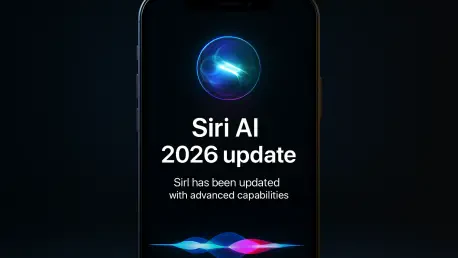Imagine a world where a virtual assistant not only responds to commands but anticipates needs, seamlessly integrates with every app on a device, and understands the context of a user’s daily life with uncanny precision. This vision, long promised by Apple through its iconic assistant Siri, appears to be on the horizon with a transformative update slated for spring 2026 in iOS 26.4. Delayed from an earlier expected timeline, this AI-driven revamp is generating significant buzz for its potential to revolutionize how users interact with Apple’s ecosystem. From iPhones to Macs, the update aims to position Siri as the ultimate voice-first interface, fulfilling a dream that has lingered since its debut over a decade ago. The stakes are high, as this overhaul could either cement Apple’s leadership in intelligent interfaces or risk falling short of towering expectations. With advanced technologies at play, the upcoming changes promise to elevate user experience to unprecedented levels, setting the stage for a deeper exploration of what’s in store.
Unveiling a New Era of Intelligence
The cornerstone of Siri’s 2026 transformation lies in the integration of cutting-edge AI, particularly Large Language Models (LLMs), which are set to enhance its conversational and operational capabilities dramatically. Unlike previous updates that offered incremental improvements, this overhaul is designed to make Siri a central hub for interaction across Apple devices, including iPad and Vision Pro. Features like App Intents will enable hands-free control of applications, allowing users to perform complex tasks without touching their screens. Additionally, personal context awareness will let Siri tailor responses based on individual habits and past interactions. This leap forward, as highlighted by industry experts, could rival the intelligence of leading AI tools while maintaining deep integration within Apple’s ecosystem. If executed well, this update might not just improve functionality but redefine how users perceive virtual assistance, turning routine tasks into fluid, intuitive experiences that feel almost second nature.
Beyond the technical upgrades, the revamped Siri is expected to excel in on-screen understanding and cross-app functionality, addressing long-standing user frustrations with its limited scope. Picture a scenario where Siri not only processes a spoken request to schedule a meeting but also pulls relevant details from emails, suggests calendar slots, and sends invites—all without manual input. This level of automation signals a shift toward a truly proactive assistant, one that anticipates needs based on device usage patterns. The ambition here is clear: to create a seamless interaction model that feels less like issuing commands and more like conversing with a knowledgeable companion. However, the complexity of weaving such intelligence into a cohesive system cannot be understated. Apple faces the challenge of ensuring these features work flawlessly across diverse user scenarios, a task that will test the boundaries of current AI implementation. Success in this arena could set a new benchmark for what virtual assistants are capable of achieving in everyday life.
Balancing Innovation with Challenges
While the potential of Siri’s 2026 update sparks excitement, it also comes with significant hurdles that Apple must navigate to deliver on its promises. One pressing concern is the risk of underperformance, especially given past criticisms of Siri lagging behind competitors in terms of innovation and responsiveness. The delay to 2026, though strategic, underscores the importance of avoiding a rushed release that could tarnish the assistant’s reputation further. If the revamped system fails to meet the high expectations set by its ambitious feature list, it might alienate users who have waited years for meaningful progress. Moreover, the technical challenge of integrating LLMs into a platform as vast as Apple’s ecosystem requires meticulous execution to ensure stability and accuracy. The balance between pushing boundaries and maintaining reliability will be critical, as any misstep could overshadow the groundbreaking aspects of this update, leaving users skeptical of future enhancements.
Another vital aspect to consider is the privacy implications of Siri’s enhanced capabilities, particularly as it gains access to deeper layers of personal data to provide context-aware assistance. With features designed to understand user behavior and preferences, Apple must reassure its audience that security remains a top priority. Striking a balance between personalization and data protection will be paramount, especially in an era where trust in tech companies is often tested. The company’s track record of emphasizing user privacy offers some confidence, but the scale of this overhaul introduces new complexities. Transparent communication about how data is handled and safeguarded will likely play a key role in shaping public perception. As the 2026 rollout approaches, the tech community will be watching closely to see if Apple can deliver an intelligent assistant that not only wows with innovation but also upholds the values that have long defined its brand ethos.
Looking Ahead to a Transformative Milestone
Reflecting on the journey, the anticipation surrounding Siri’s 2026 update marks a pivotal chapter in Apple’s pursuit of AI excellence. The discussions around advanced features like App Intents and personal context awareness have captured imaginations, painting a picture of a future where technology feels effortlessly intuitive. Industry voices have weighed in with a mix of optimism and caution, acknowledging the transformative potential while recognizing the execution risks that loom large. Privacy concerns have also surfaced as a critical point of focus, reminding everyone of the delicate balance between innovation and trust that Apple must maintain.
As this milestone draws closer, attention turns to actionable steps for ensuring success. Apple needs to prioritize rigorous testing to iron out any flaws in Siri’s new architecture, while clear user education on privacy controls could help build confidence. For users, staying informed about the update’s progress offers a chance to prepare for a redefined digital experience. This moment in Apple’s history stands as a testament to the power of patience and precision, with the potential to reshape how technology serves daily life in profound ways.









